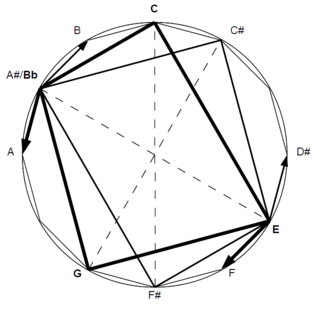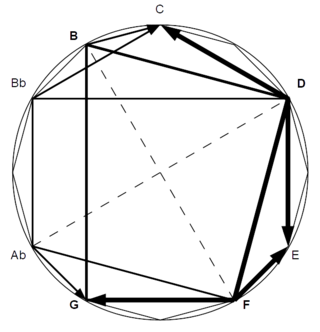Triads (common practice style)
When used with chord symbols, the Roman numerals represent the root of a triad built on the associated scale step. In music theory based on the practices of the common practice period and its derivations the chord numerals are often written in upper case for chords in the major family, and in lower case for chords in the minor family, with the usual "m" or "—" minor chord quality suffix omitted outright:
- E♭ becomes I
- Fm7 becomes ii7
- Gm7 becomes iii7
- A♭maj7 becomes IV maj7
- B♭7 becomes V7
- Cm7 becomes vi7
- Dø7 becomes viiø7
When representing the triads rooted in a minor key, the upper or lower case of the numerals indicate both its chord quality and that the key is minor:
- Cm7 becomes i7
- Dø7 becomes iiø7
- E♭ becomes III
- Fm7 becomes iv7
- Gm7 becomes v7
- A♭maj7 becomes VI maj7
- B♭7 becomes VII7
A major drawback of using this method is its lack of use of accidentals. While in the numeric system, flats and sharps can be represented either by the use of fractions (e.g. an A natural in the scale above becomes 4+1⁄2) or, more commonly in written text, by inserting an accidental before the number (e.g. the same note becomes ♭5 or ♯4).
Triads (jazz and popular style)
In music theory aimed towards jazz and popular music, all triads are represented by upper case numerals, followed by a symbol to indicate if it is not a major chord (e.g. "m" for minor or "ø" for half-diminished):
- E♭maj7 becomes I maj7
- Fm7 becomes IIm7
- Gm7 becomes IIIm7
- A♭maj7 becomes IV maj7
- B♭7 becomes V7
- Cm7 becomes VIm7
- Dø7 becomes VIIø7
When representing the triads rooted in a minor key, accidentals are used to indicate the chromatic alteration from the assumed major key roots indicated by numerals that don't have accidentals:
E♭ minor:
- E♭m7 becomes Im7
- Fmø7 becomes IIø7
- G♭maj7 becomes ♭IIImaj7 (the assumed pitch for the root of a III numeral in E♭ is G, and the ♭ is required to indicate that, in E♭ minor, this chord is rooted on G♭)
- A♭m7 becomes IVm7
- B♭m7 becomes Vm7
- C♭maj7 becomes ♭VImaj7
- D♭7 becomes ♭VII7
This will frequently result in numerals whose accidentals are different than those of the actual root note, as they are referring to a change from the assumed pitch and not an absolute pitch:
D minor:
- Dm7 becomes Im7
- Emø7 becomes IIø7
- Fmaj7 becomes ♭III maj7 (the assumed pitch for the root of a III numeral in D is F♯, and the ♭ is required to indicate that, in D minor, this chord is rooted on F)
- Gm7 becomes IVm7
- Am7 becomes Vm7
- B♭maj7 becomes ♭VI maj7
- C7 becomes ♭VII7

The major scale is one of the most commonly used musical scales, especially in Western music. It is one of the diatonic scales. Like many musical scales, it is made up of seven notes: the eighth duplicates the first at double its frequency so that it is called a higher octave of the same note.
In music theory, a leading-tone is a note or pitch which resolves or "leads" to a note one semitone higher or lower, being a lower and upper leading-tone, respectively. Typically, the leading tone refers to the seventh scale degree of a major scale, a major seventh above the tonic. In the movable do solfège system, the leading-tone is sung as ti.

A chord, in music, is any harmonic set of pitches consisting of multiple notes that are sounded simultaneously, or nearly so. For many practical and theoretical purposes, arpeggios and other types of broken chords may also be considered as chords in the right musical context.
In music theory, an augmented sixth chord contains the interval of an augmented sixth, usually above its bass tone. This chord has its origins in the Renaissance, was further developed in the Baroque, and became a distinctive part of the musical style of the Classical and Romantic periods.
In music, the subtonic is the degree of a musical scale which is a whole step below the tonic note. In a major key, it is a lowered, or flattened, seventh scale degree. It appears as the seventh scale degree in the natural minor and descending melodic minor scales but not in the major scale. In major keys, the subtonic sometimes appears in borrowed chords. In the movable do solfège system, the subtonic note is sung as te.
Chromaticism is a compositional technique interspersing the primary diatonic pitches and chords with other pitches of the chromatic scale. In simple terms, within each octave, diatonic music uses only seven different notes, rather than the twelve available on a standard piano keyboard. Music is chromatic when it uses more than just these seven notes.
The diminished seventh chord is a four-note chord composed of a root note, together with a minor third, a diminished fifth, and a diminished seventh above the root:. For example, the diminished seventh chord built on B, commonly written as Bo7, has pitches B-D-F-A♭:
In music, a minor seventh chord is a seventh chord composed of a root note, a minor third, a perfect fifth, and a minor seventh. In other words, one could think of it as a minor triad with a minor seventh attached to it.

In music theory, chord substitution is the technique of using a chord in place of another in a progression of chords, or a chord progression. Much of the European classical repertoire and the vast majority of blues, jazz and rock music songs are based on chord progressions. "A chord substitution occurs when a chord is replaced by another that is made to function like the original. Usually substituted chords possess two pitches in common with the triad that they are replacing."

Jazz harmony is the theory and practice of how chords are used in jazz music. Jazz bears certain similarities to other practices in the tradition of Western harmony, such as many chord progressions, and the incorporation of the major and minor scales as a basis for chordal construction. In jazz, chords are often arranged vertically in major or minor thirds, although stacked fourths are also quite common. Also, jazz music tends to favor certain harmonic progressions and includes the addition of tensions, intervals such as 9ths, 11ths, and 13ths to chords. Additionally, scales unique to style are used as the basis of many harmonic elements found in jazz. Jazz harmony is notable for the use of seventh chords as the basic harmonic unit more often than triads, as in classical music. In the words of Robert Rawlins and Nor Eddine Bahha, "7th chords provide the building blocks of jazz harmony."

In jazz and jazz harmony, the chord progression from iv7 to ♭VII7 to I (the tonic or "home" chord) has been nicknamed the backdoor progression or the backdoor ii-V, as described by jazz theorist and author Jerry Coker. This name derives from an assumption that the normal progression to the tonic, the ii-V-I turnaround (ii-V7 to I, see also authentic cadence) is, by inference, the "front door", a metaphor suggesting that this is the main route to the tonic.

Rhythm changes is a common 32-bar jazz chord progression derived from George Gershwin's "I Got Rhythm". The progression is in AABA form, with each A section based on repetitions of the ubiquitous I–vi–ii–V sequence (or variants such as iii–vi–ii–V), and the B section using a circle of fifths sequence based on III7–VI7–II7–V7, a progression which is sometimes given passing chords.
The harmonic minor scale is a musical scale derived from the natural minor scale, with the minor seventh degree raised by one semitone to a major seventh, creating an augmented second between the sixth and seventh degrees.
In music theory, the half-diminished seventh chord is a seventh chord composed of a root note, together with a minor third, a diminished fifth, and a minor seventh. For example, the half-diminished seventh chord built on B, commonly written as Bm7(♭5), or Bø7, has pitches B-D-F-A:
The Nashville Number System is a method of transcribing music by denoting the scale degree on which a chord is built. It was developed by Neal Matthews and his brother Monty Matthews, in the late 1950s as a simplified system for the Jordanaires to use in the studio and further developed by Charlie McCoy. It resembles the Roman numeral and figured bass systems traditionally used to transcribe a chord progression since the 1700s. The Nashville Number System was compiled and published in a book by Chas. Williams in 1988.
The Nashville Number System is a trick that musicians use to figure out chord progressions on the fly. It is an easy tool to use if you understand how music works. It has been around for about four hundred years, but sometime during the past fifty years [approximately 1953–2003], Nashville got the credit.
The Nashville numbering system provided us the shorthand that we needed so that we could depend on our ears rather than a written arrangement. It took far less time to jot the chords, and once you had the chart written, it applied to any key. The beauty of the system is that we don't have to read. We don't get locked into an arrangement that we may feel is not as good as one we can improvise.
In music, harmonization is the chordal accompaniment to a line or melody: "Using chords and melodies together, making harmony by stacking scale tones as triads".
In music theory, Roman numeral analysis is a type of harmonic analysis in which chords are represented by Roman numerals, which encode the chord's degree and harmonic function within a given musical key.
Musicians use various kinds of chord names and symbols in different contexts to represent musical chords. In most genres of popular music, including jazz, pop, and rock, a chord name and its corresponding symbol typically indicate one or more of the following:
- the root note,
- the chord quality,
- whether the chord is a triad, seventh chord, or an extended chord,
- any altered notes,
- any added tones, and
- the bass note if it is not the root.
The jazz minor scale or ascending melodic minor scale is a derivative of the melodic minor scale, except only the ascending form of the scale is used. As the name implies, it is primarily used in jazz, although it may be found in other types of music as well. It may be derived from the major scale with a minor third, making it a synthetic scale, and features a dominant seventh chord on the fifth degree (V) like the harmonic minor scale. It can also be derived from the diatonic Dorian mode with a major seventh.

The Royal Road progression (王道進行, ōdō shinkō), also known as the IVM7–V7–iii7–vi progression or koakuma chord progression (小悪魔コード進行, koakuma kōdo shinkō), is a common chord progression within contemporary Japanese pop music.






